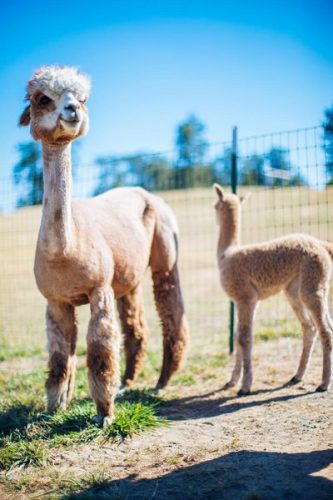
I own a tiny grey alpaca named Shimmer. I bought her for $250 two winters ago and she hasn’t stopped costing me money since. I’m building a small fiber business, selling Oregon yarn and hand knits online. I’m about wool. One year into my ambitious little alpaca fiber program, I thought Shimmer would be 1) pregnant by now 2) friendlier to me and 3) well … friendlier to me.
Turns out Shimmer did not get pregnant on her first try back in November with a national champion alpaca stud (despite two 20-minute sessions of fiber freak dancing with a very expensive lover).
I board Shimmer and her “companion” alpaca, Cutie, at Pura Vida Alpacas, a local alpaca farm outside Eugene run by Robin Freedman.
Cutie, unlike Shimmer, got preggers on the first try and is now due in August. Did you know the gestation period of an alpaca is 11 months? And they typically birth just one adorable and fuzzy little baby. Unlike sheep, who can pump out twins twice a year, alpacas make babies like aged fine wine; they let that embryo marinate for a good long while before anyone makes money.
Higher-end alpacas like Shimmer and the others at Pura Vida Alpacas can turn a profit either through their luxurious fleeces, raw or processed into yarn, rugs or hand-knit items. With the right genetics to impress a buyer, a young baby alpaca off a farm can sell for $1,500 and upward.
However, broke-ass alpaca lovers like me tend to buy them Craigslist-style, from $100 to $350. For me, Cutie’s new baby will mean the softest of fibers and a potential sale within a year.
Driving out to their boarding farm in Goshen every few weeks is a cozy break from my life as a doctorate student at the University of Oregon. As herd animals, alpacas like to do everything in a group. When I’m out in the barn, several dozen ladies love to crowd around me, humming and accosting me with their nibbly warm alpaca lips. It’s a lot like being surrounded by sweet, giant bunny rabbits that whirr.
You may be asking yourself, what inspired me to bring an expensive, doe-eyed little wonder into my life?
Last year, I was down in Medford buying alpaca fleeces at a farm for spinning. I asked the farmer if I could see her animals, so we wandered over to the fence line. Two dozen brown-eyed alpaca ladies stared back at me, their long, beautiful lashes blowing in the wind. They smelled good.
And then I saw a tiny little grey girl alpaca in the back, with splashes of color in her spotted silver fleece. She had wide Disney princess eyes and was a good foot shorter than her peers. She gazed at me — me, specifically! I felt a nudge on my heart that could only mean one thing: “Falling in love with those big brown eyes is gonna make me broke as hell.”
I timidly asked the farmer how much she would cost. $250, she replied, but you’ll need a companion alpaca for her for an additional $250. Plus, of course, the gas to transport them from Medford to Eugene.
I bit the bullet and started mailing monthly checks down to Medford to buy my two sweet alpaca girls. I figured the investment into my online fiber store could one day mean more alpacas, more fiber and the potential to have them pay for their keep through fleeces and new babies. You shear an alpaca once a year, yielding a 2- to 4- pound fleece. Raw, a fleece usually sells between $20 to $95, depending on the fineness and cleanliness of the fibers.
If Shimmer does get pregnant this year or next, I’m hoping she’ll have a doe-eyed grey baby girl. One reason I loved Shimmer in the first place was her tremendously beautiful fleece, which is a silky soft tapestry of grey, charcoal and raspberry spots with a nice length to the fibers. Grey is the most sought after color of fiber among alpacas.
Under a microscope, a grey fleece actually consists of shades of white to silver to charcoal, creating a spinner’s paradise of complex depth in the yarn. My girl Cutie is a red-penny color and stands a foot taller than her friend Shimmer. Unlike Shimmer, Cutie is definitely starting to show her little baby bump.
Despite the ongoing cost to care for my girls, ($600 a year to board the two, a $70 yearly shearing fee, a one-time stud fee) I’m hoping they’ll eventually be the grandmothers of my own alpaca flock. Maybe one day I’ll have three or four baby Shimmers running around. I could shear them and get my $500 back.